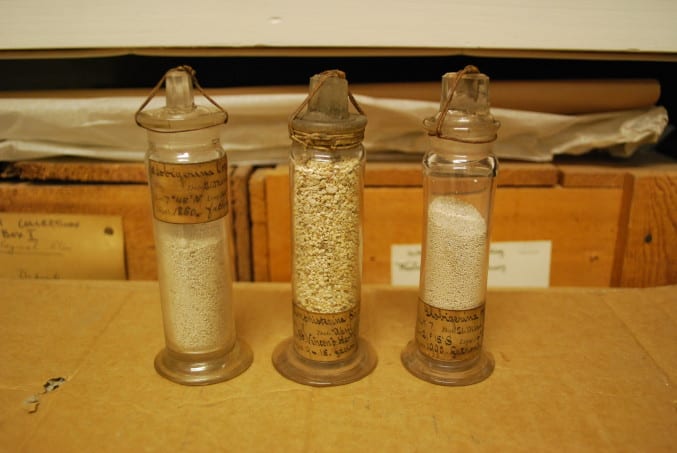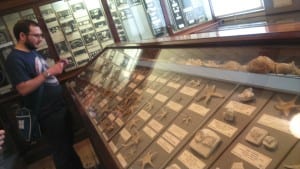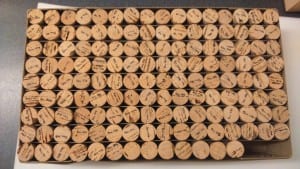High Seas and Deep Waters: The HMS Challenger collection
Posted on by Fay Curtis.
Deborah Hutchinson, Curator – Geology
It’s amazing what you find when you’re looking for something else in the geology store at Bristol Museum & Art Gallery. Tucked away under shelves that carefully hold the fossils of Ice Age beasts in the geology store were two old wooden boxes labelled in faint pencil: ‘HMS Challenger’ – how exciting!
The HMS Challenger expedition set out from Portsmouth in 1872 and was the first around-the-world expedition to explore the life, chemistry and the physics of the deep open seas of the world.
The expedition visited many exciting and distant places and collected many samples of sediments and animals alongside countless scientific measurements. On their return in 1876 the collections were distributed to many museums and institutions for scientists to study. Exeter’s Royal Albert Memorial Museum has undertaken a project to reunite all these collections, have a look at their website to learn more.
So how did Bristol Museum & Art Gallery end up with collections from this important expedition? This is due to one man: Frederick Gordon Pearcey (1857 1927).
Pearcey was born in Middlesex and joined the Challenger expedition in 1872 at the age of fifteen or sixteen, making him the youngest member of the expedition. During the expedition Pearcey was a taxidermist and general scientific assistant. On the completion of the voyage he assisted Sir Wyville Thomson and Sir John Murray in the Challenger Office at Edinburgh. Here he gained skills in identifying species, especially of foraminifera (microscopic organisms that are very beautiful and often used for dating rocks), on which he wrote several papers. Fifty volumes were written on the expedition, with a total of nearly 30,000 pages and took nearly twenty years after the expedition to be written.
All the reports and various maps from the expedition are available online.

Three examples of original glass vials containing deep sea sediment collected on the HMS Challenger expedition (1872 – 1876). The labels indicated the name of the sediment, what station number it was collected from and from how deep, in fathoms!
Pearcey came to Bristol in 1905, when the museum was still housed in what’s now Browns, where he worked as the assistant curator of zoology. It’s probably during his time as assistant curator that Pearcey donated his collection of Challenger material to the museum. This collection has now been curated by geology volunteer Charlie Navarro.
During Pearcey’s time at Bristol he made a series of models of his favourite foraminifera which were made of glass and plaster. Pearcey also used his taxidermy skills and worked on various specimens, some of which are still in the collection today.

Geology volunteer Charlie Navarro visiting the W.P.Sladen collection of HMS Challenger material on display at the Royal Albert Memorial Museum in Exeter.
Pearcey died on January 26th 1927, at the age of seventy in Newport, Wales (you can read his obituary). He was the last surviving member of the Challenger expedition. He is still remembered today as one of the earliest scientist to work on foraminifera, and we are very lucky to have this material in our collections.
Material from HMS Challenger will be on display at Bristol Rocks! our family Geology Take Over day on Saturday 9 April at Bristol Museum & Art Gallery.

11 comments on “High Seas and Deep Waters: The HMS Challenger collection”
Hello from Western Canada.
Frederick Gordon Pearcey was my Greatgrandfather His daughter Rhoda Margaret Pearcey Handegord was my paternal grandmother. I have in my possesion, as given to me as the eldest grand daughter, his personal shell collection, with his spy glass, notebook, and some small glass vials with specimens. I also have an 1884 photograph of the Challenger Office staff which is framed with wood taken from the main top mast of the HMS Challenger (as noted on a metal plaque at the bottom of the frame).
I have always wanted to visit Edinburgh and Bristo. I was aware that his portrait hangs? in the Bristol Natural History Museum.
Thank you so very much for posting this information.
with fond regards,
Kathryn S. Handegord Gowling FRAIC
Hi Kathryn, we must be related as Frederick is my Great, great grandfather on my mothers side. Wonderful that you have these items. Kind Regards Karen Dickson, Edinburgh, Scotland.
Dear Kathryn and Karen,
Thank you so much for getting in touch, what a lovely surprise and what a lovely story! It would be fantastic to get in touch with you both and perhaps swap stories about your great grandfather? We have more Pearcey material in our stores that you might be interested in, he was quite the collector, but I’m sure you knew that already. We do indeed have your great grandfathers portrait, painted by his brother, currently cared for in the biology department. If you would like, please get in touch via the ‘contact us’ page as it would be fantastic to learn more about him, and hopefully I can pass on any information we have here at the museum.
Kindest regards from Bristol,
Deborah Hutchinson – Geology Curator
Dear Miss Hutchinson:
My name is Enrique Carrasco, a professor at the European University of the Canary Islands and a researcher in the History of Navigation. I take this opportunity to wish you a Happy New Year 2019!
The purpose of my email is to ask if there is any way to gather more information about the biography of Frederick Gordon Pearcey (1857 1927), taxidermist on the HMS Challenger expedition, with the aim of completing his biographical data for an research that I am doing in these moments.
Currently, the only data that I have been able to find are those that will appear written in the Pearcey obituary.
Very grateful in advance,
Best regards,
PhD. Enrique Carrasco Molina
Professor and researcher
Grados en Comunicación Publicitaria, Dirección y Creación de Empresas, Marketing
Universidad Europea de Canarias
Dear Enrique,
Great to hear from you. Of course we can provide as much information as we have regarding F.G. Pearcey – I’ll email you directly.
Best Wishes,
Deborah
Hello Kathryn Gowling,
What a coincidence! Last week I was at the National Oceanographic Library in Southampton studying papers about Frederick Gordon Pearcey’s final months, at which time there was a vigorous movement in the scientific community supporting an application to the Government for a Civil List Pension on his behalf.
I’m a retired oceanographer whose main area of research is the Challenger Expedition, particularly its scientific staff, their publications, and the history of its massive Report. The papers in Southampton include several letters from Pearcey and his son, together with a list of his publications. If you are interested, I will send you more details by post, c/o Pynelogs Cultural Centre. With best wishes,
Im undertaking family history research for my partner, and have discovered that Frederick Gordon Pearcey is my partners great great grandfather. His daughter Elizabeth Finlay Pearcey born Edinburgh being her great grandmother. We live in Edinburgh ourselves.
Hi John,
Thank you for your post, really interesting to learn that there are Pearcey letters in the National Oceanographic Library, Southampton. I must take a look!
Deborah Hutchinson
Bristol Museum
Hi Mark,
Thank you for your post. It looks like we are putting together a Pearcey family tree from the responses here. Perhaps we need to organise a mini family reunion?! Good luck with the research.
Best,
Deborah Hutchinson
Bristol Museum
It is wonderful to see so many people interested in Frederick Pearcey’s story. I always bring him up in my presentations about HMS Challenger. He is a wonderful example of how the expedition involved the work of many, many people – not just the few famous scientists who are usually mentioned.
If anyone is interested in giving a short talk about Pearcey or attending an interdisciplinary conference about the Challenger Expedition on 7 November 2023, please see the National Maritime Museum, Greenwich website: https://www.rmg.co.uk/whats-on/national-maritime-museum/beyond-oceans-depths-revisiting-challenger-expedition-1872-1876.
All the best
Erika Jones
Curator of Navigation and Oceanography
Hi Deborah,
I’m working on a paper hoping to provide a more complete narrative of the experience and contribution of the Able Seamen and Boys to the success of the voyage.
Did you manage to access the Pearcey letters in the National Oceanographic Library, Southampton – were they fruitful, as I imagine they would be.
My great grandfather, Charlie Collins, was the Chief Stoker – my book, A Challenger’s Song, brings together the threads of family oral history about Charlie with a wider take on the expedition from the standpoint of the crew.
https://a-challengers-song.co.uk/
Great to read the many responses to your post.
All the best,
Philip
London